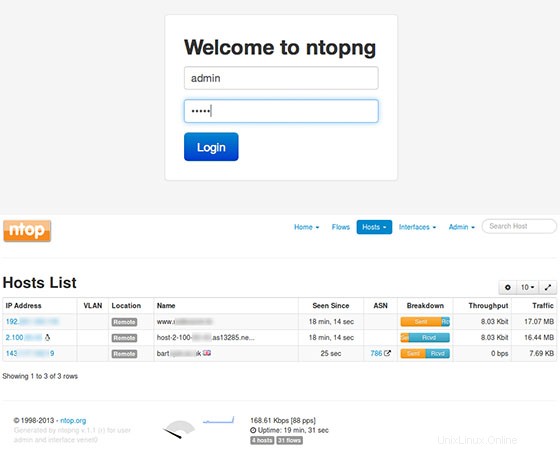
In diesem Tutorial zeigen wir Ihnen, wie Sie Ntopng unter Ubuntu 16.04 installieren und konfigurieren. Für diejenigen unter Ihnen, die es nicht wussten, ist Ntopng ein relativ nützliches Tool, wenn Sie überwachen möchten verschiedene Netzwerkprotokolle auf Ihren Servern. Es bietet eine Reihe von Tools zur Überwachung verschiedener Protokolle, Verkehrsvarianten und ja, Bandbreite über mehrere Zeitrahmen hinweg. Ntopng basiert auf libpcap und wurde portabel geschrieben, um virtuell darauf zu laufen jede Unix-Plattform, MacOSX und auch auf Win32.
Dieser Artikel geht davon aus, dass Sie zumindest über Grundkenntnisse in Linux verfügen, wissen, wie man die Shell verwendet, und vor allem, dass Sie Ihre Website auf Ihrem eigenen VPS hosten. Die Installation ist recht einfach und setzt Sie voraus im Root-Konto ausgeführt werden, wenn nicht, müssen Sie möglicherweise 'sudo hinzufügen ‘ zu den Befehlen, um Root-Rechte zu erhalten. Ich zeige Ihnen Schritt für Schritt die Installation von Ntopng auf einem Ubuntu 16.04 LTS (Xenial Xerus) Server.
Ntopng unter Ubuntu 16.04 installieren
Schritt 1. Überprüfen Sie zunächst, ob das Universums-Repository aktiviert ist, indem Sie „/etc/apt/sources.list überprüfen ‘ mit Ihrem bevorzugten Editor.
sudo gedit /etc/apt/sources.list
Wenn das Universum nicht enthalten ist, ändern Sie die Datei so, dass es Folgendes tut:
deb http://us.archive.ubuntu.com/ubuntu xenial main universe
Schritt 2. Ntopng installieren.
Um Ntopng zu installieren, führen Sie den folgenden Befehl als Root-Benutzer Ihres Servers aus:
sudo apt-get install redis-server sudo apt-get install ntopng
Schritt 3. Konfigurieren Sie Ntopng.
Erstellen Sie eine Ntopng-Konfigurationsdatei. In diesem Artikel verwenden wir nano als Texteditor. Sie können Ihren bevorzugten Texteditor verwenden, um Ntopng-Konfigurationsdateien zu erstellen:
sudo nano /etc/ntopng/ntopng.conf
# /etc/ntopng/ntopng.conf # # The configuration file is similar to the command line, with the exception that an equal # sign '=' must be used between key and value. Example: -i=p1p2 or --interface=p1p2 For # options with no value (e.g. -v) the equal is also necessary. Example: "-v=" must be used. # # # -G|--pid-path # Specifies the path where the PID (process ID) is saved. # -G=/var/tmp/ntopng.pid # # -e|--daemon # This parameter causes ntop to become a daemon, i.e. a task which runs in the background # without connection to a specific terminal. To use ntop other than as a casual monitoring # tool, you probably will want to use this option. # -e= # # -i|--interface # Specifies the network interface or collector endpoint to be used by ntopng for network # monitoring. On Unix you can specify both the interface name (e.g. lo) or the numeric # interface id as shown by ntopng -h. On Windows you must use the interface number instead. # Note that you can specify -i multiple times in order to instruct ntopng to create multi‐ # ple interfaces. # -i=1 # # -w|--http-port # Sets the HTTP port of the embedded web server. # -w=3000 # # -m|--local-networks # ntopng determines the ip addresses and netmasks for each active interface. Any traffic on # those networks is considered local. This parameter allows the user to define additional # networks and subnetworks whose traffic is also considered local in ntopng reports. All # other hosts are considered remote. If not specified the default is set to 192.168.1.0/24. # # Commas separate multiple network values. Both netmask and CIDR notation may be used, # even mixed together, for instance "131.114.21.0/24,10.0.0.0/255.0.0.0". # -m=192.168.1.0/24 # # -n|--dns-mode # Sets the DNS address resolution mode: 0 - Decode DNS responses and resolve only local # (-m) numeric IPs 1 - Decode DNS responses and resolve all numeric IPs 2 - Decode DNS # responses and don't resolve numeric IPs 3 - Don't decode DNS responses and don't resolve # -n=1 # # -S|--sticky-hosts # ntopng periodically purges idle hosts. With this option you can modify this behaviour by # telling ntopng not to purge the hosts specified by -S. This parameter requires an argu‐ # ment that can be "all" (Keep all hosts in memory), "local" (Keep only local hosts), # "remote" (Keep only remote hosts), "none" (Flush hosts when idle). # -S= # # -d|--data-dir # Specifies the data directory (it must be writable). Default directory is ./data # -d=/var/tmp/ntopng # # -q|--disable-autologout # Disable web interface logout for inactivity. # -q=
Datei ntopng.start erstellen:
sudo nano /etc/ntopng/ntopng.start ##Add this line## --local-networks "192.168.0.0/24" ## give your local IP Ranges here. --interface 1
Um alle verfügbaren Schnittstellen und Optionen anzuzeigen, verwenden Sie ntopng -h Möglichkeit:
sudo ntopng -h
Ntopng-Server-Daemon starten:
systemctl start ntopng.service systemctl start redis-server.service
Schritt 4. Ntopng testen.
Jetzt können Sie Ihre Ntopng-Anwendung testen, indem Sie http://your-domain:3000 eingeben . Sie sehen die Anmeldeseite von Ntopng. Zum ersten Mal können Sie den Benutzer „admin“ und das Passwort „admin“ verwenden.

Herzlichen Glückwunsch! Sie haben Ntopng erfolgreich installiert. Vielen Dank, dass Sie dieses Tutorial zur Installation der webbasierten Hochgeschwindigkeits-Verkehrsanalyse und Datenflusserfassung von Ntopng auf Ihrem Ubuntu 16.04-System verwendet haben. Für zusätzliche Hilfe oder nützliche Informationen, Wir empfehlen Ihnen, die offizielle Ntopng-Website zu besuchen.